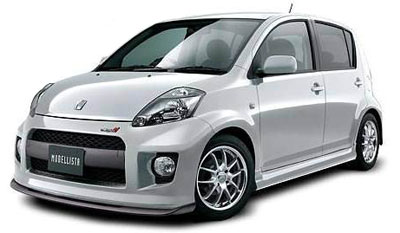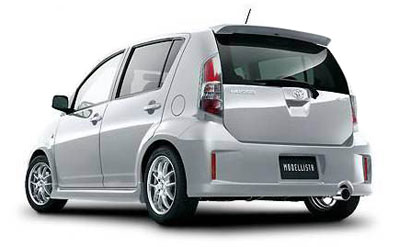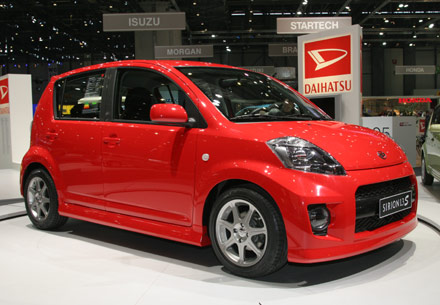For all you people who are planning to buy the Perodua Myvi, there’s a TRD bodykit out there for the Toyota equivalent which is the Toyota Passo. Can’t wait to see Myvis on the road with this kit slapped on. Looks darn good.


Perodua Myvi, Myvi, Perodua, Price, Bodykit, New Facilite, Colour
For all you people who are planning to buy the Perodua Myvi, there’s a TRD bodykit out there for the Toyota equivalent which is the Toyota Passo. Can’t wait to see Myvis on the road with this kit slapped on. Looks darn good.



If you experience a sense of déjà vu when you see the Perodua Myvi, it's easily explained. No, you don't have extra-sensory powers to see into the future, but you are likely to have seen this car before - just with a different set of badges. The Myvi is Perodua's take on the Daihatsu Sirion, which itself shares the bulk of its bits with the Subaru Justy. To cap it all, all three are based on a pint-pot 
With those other companies in its credentials, there's no doubt the Myvi is the car to shake off Perodua's cheap and cheerless image in the UK. We've no doubt it will be a reliable helper when it comes to getting about, but it's a shame Perodua doesn't have quite the same confidence to endow it with anything more than a 36,000-mile, three-year warranty. This is all the stranger when Daihatsu and Subaru provide cover for 60,000 miles. Still, the Myvi is well put together, though some of the interior plastics are hard, shiny and missing the visual charm of several other rivals. Given how much Perodua charges for the Myvi, there are also no excuses on the grounds of this car being in the bargain-basement price range. For the same money as the Myvi, there are some brilliant city cars and superminis available, including the Fiat Panda and Ford 
For the money, Perodua includes a fair amount of standard 

Some compensation comes in the Myvi's surprisingly spacious cabin. Thanks to its tall sides and seats that put its occupants in a comfortable, upright position, there's good head and legroom. The steering wheel only adjusts for angle, but the driver's seat moves for height, so a good driving position is easily attained by most users. Rear seats space is good and the small boot is unhindered by intrusions to make the most of its 255-litre capacity. Fold the 60/40 split rear seats and you have up to 630 litres of cargo space. The Myvi also rewards with low running costs thanks to group 6 insurance and cheap servicing, but it must be remembered that it will not hold its value as dependably as some of its competition. Still, once you're over the feeling of déjà vu, you're not likely to encounter another Perodua Myvi on the road.

For all you people who are planning to buy the Perodua Myvi, there’s a TRD bodykit out there for the Toyota equivalent which is the Toyota Passo. Can’t wait to see Myvis on the road with this kit slapped on. Looks darn good.


There are also alot of other bodykits available for the Passo.
TRD Sports M
Passo Modellista
Passo Kenstyle
Passo Gialla
Passo Wald

Isn’t she a beauty?
Here’s what I gathered about the new Perodua Myvi. Since the media test drive, alot of things speculated about the Perodua Myvi has been answered by the team at Perodua themselves.
Engine
The 1 liter Myvi which is the Perodua Myvi 1.0SR will be using the EJ-VE 1 liter 3 cylinder DOHC engine, an upgraded version of the EJ-DE 1 liter 3 cylinder DOHC found in the Kenari/Kelisa. When I say upgraded, I mean it comes with DVVT variable valve timing. This EJ-VE DVVT engine is also found in export models of the Perodua Kelisa intended for the UK market.
As a comparison, the 1.3 Toyota Passo/Daihatsu Boon uses the same K3-VE as our 1.3 Perodua Myvi but the 1.0 Toyota Passo/Daihatsu Boon uses the 1KR-FE 1.0 engine with variable valve timing instead of the EJ-VE that our 1.0 Perodua Myvi has. This is probably an updated 1 liter engine design as compared to the EJ series that we’re still using.
The 1.3 liter Myvi, available in 4 trim levels (1.3SX, 1.3EZ, 1.3SXi, 1.3EZi) is using the K3-VE engine found in the Kembara DVVT, which has variable valve timing. I suspect YRV Turbo halfcuts with the K3-VET in them will be even more popular now ![]()
Power output for the 1 liter EJ-VE is 56hp and the 1.3 liter K3-VE produces 85hp. As a Comparison, the Honda Jazz 1.5 VTEC produces 110hp and the Jazz 1.5 i-DSI produces 87hp too. So you can see, the variable valve timing feature on the K3-VE really makes it comparable to 1.5 liter engines not equipped with any form of variable valve timing.
Transmission/Gearbox
There are manual and automatic transmission available. The manual is a 5-speed while the auto is a 4-speed with overdrive. This should help with the highway cruising fuel consumption.
Specifications/Trim Levels
There are four models available. The prices shown are including insurance.
| Model | Specs | Price |
| Myvi 1.0SR | 1.0, Manual | RM41,200 |
| Myvi 1.3SX | 1.3, Manual | RM44,755/RM45,300 |
| Myvi 1.3EZ | 1.3, Auto | RM47,781/RM48,300 |
| Myvi 1.3SXi | 1.3, Manual, Dual Airbags, ABS | RM47,781/RM48,300 |
| Myvi 1.3EZi | 1.3, Auto, Dual Airbags, ABS | RM50,781/RM51,300 |
Looks like the price for the 1.3SXi and the 1.3EZ is the same. If you could only afford that much and not the 1.3EZi, would you choose an automatic transmission or the dual airbags and ABS? ![]()
The 1.3 cars are available in all seven colours but the 1.0 is only available in black, gold and silver. All the 1.3 versions have 14 inch alloy rims while the 1.0 only has steel rims. Looks like the 1.0SR is the ultra-budget version of the Myvi.
Quality Control Standards
QC, or rather the lack of QC is the problem plaguing Malaysian car manufacturers. Perodua is definitely much better than Proton in terms of quality control. And with recently being commissioned to manufacture the Toyota Avanza for Toyota, it’s factory’s QC had been beefed up so that it matches Toyota’s standards. Defect rates are currently at 0.2, which means 2 defects per 10 cars. This is a huge improvement from the rate of 2 to 2.5 per car 10 years ago.
So here you go, everyone’s questions about the prices and the models available answered! Before I end this post, let me leave you with some spyshots.
The one on the left is the 1.3EZi or one of the 1.3 models I presume and the one on the right is the 1.0SX. You can see the exterior differences for the two models. The higher spec Myvi has foglamps on the bumper but the 1.0 model does not. The 1.0 model also has wheelcaps covering the ugly steel rims but the 1.3 model has proper alloy wheels. Oh yes, check out the side mirrors for the Myvi, they have signal lamps on them. Kind of cool ![]() Yes, yes, I’m easily amused okay!
Yes, yes, I’m easily amused okay!
The Perodua Myvi has received a facelift 3 years after it was launched, at a time which would appropriately be mid-point in its lifecycle. There are updates with the exterior, interior, equipment as well as price, which naturally have been revised higher.
Continue reading after the jump for full details of the updated Myvi…
RELATED: 2008 Perodua Myvi SE Facelift – Full Details, Photos and Prices
On the exterior you get a new look on the front and the rear, more of the front than the rear actually as the rear only gets a new bumper. The front gets a new bonnet and front bumper with new foglamps but the headlamp remains the same. All 1.3 liter models get UV protection glass which are said to be able to repel 91% of harmful UV rays.
 The interior receives the option for a blue Optitron meter panel for the Premium version, a style that was introduced on the Myvi SE. The rest of the Myvi range continues to have the amber Optitron meter, and the white meter is now gone. The meter panel is now of a three-gauge design with the speedo rearranged to the middle instead of previously located on the left. The rev meter has been moved from the right to the left.
The interior receives the option for a blue Optitron meter panel for the Premium version, a style that was introduced on the Myvi SE. The rest of the Myvi range continues to have the amber Optitron meter, and the white meter is now gone. The meter panel is now of a three-gauge design with the speedo rearranged to the middle instead of previously located on the left. The rev meter has been moved from the right to the left.
The dashboard is now two tone with a separate colour for the lower section. The area where the audio and climate controls are have also been revised. The integrated audio system gains the ability to read MP3 and WMA files from CDs, and there is now a USB port (1.3 Premium only) for you to plug in a thumb drive or a media player. The system also has a Bluetooth handsfree feature (1.3 Premium only) to pipe your phone calls through the car’s audio system.
 The seats have also been redesigned with a new cover design (for 1.3 liter only) and for the premium versions now feature the ability for seat height adjustment up to 45mm.
The seats have also been redesigned with a new cover design (for 1.3 liter only) and for the premium versions now feature the ability for seat height adjustment up to 45mm.
The premium version also features a teh tarik hook at the back of the front passenger seat. All versions get an underseat tray under the front passenger seat.
The engines are unchanged. The lower end models use a 1.0 liter EJ-VE inline-3 DOHC engine with variable valve timing producing 58 horsepower at 6,000rpm and 88Nm of torque at 3,600rpm while the 1.3 liter models use the K3-VE inline-4 DOHC with variable valve timing producing 86 horsepower at 6,000rpm and 116Nm of torque at 3,200rpm.
The following is a table of the facelifted Myvi’s equipment. Click for larger version.
And the following is the new pricing for the facelifted Myvi:
| Perodua Myvi Facelift 1.0 SR M/T (Solid) | RM38,924.10 |
| Perodua Myvi Facelift 1.0 SR M/T (Metallic) | RM39,447.30 |
| Perodua Myvi Facelift 1.3 Standard M/T (Solid) | RM43,400.00 |
| Perodua Myvi Facelift 1.3 Standard M/T (Metallic) | RM43,900.00 |
| Perodua Myvi Facelift 1.3 Standard M/T (Special Metallic) | RM44,300.00 |
| Perodua Myvi Facelift 1.3 Standard A/T (Solid) | RM46,400.00 |
| Perodua Myvi Facelift 1.3 Standard A/T (Metallic) | RM46,900.00 |
| Perodua Myvi Facelift 1.3 Standard A/T (Special Metallic) | RM47,300.00 |
| Perodua Myvi Facelift 1.3 Premium M/T (Solid) | RM46,200.00 |
| Perodua Myvi Facelift 1.3 Premium M/T (Metallic) | RM46,700.00 |
| Perodua Myvi Facelift 1.3 Premium M/T (Special Metallic) | RM47,100.00 |
| Perodua Myvi Facelift 1.3 Premium A/T (Solid) | RM49,200.00 |
| Perodua Myvi Facelift 1.3 Premium A/T (Metallic) | RM49,700.00 |
| Perodua Myvi Facelift 1.3 Premium A/T (Special Metallic) | RM50,100.00 |
Interest rates are now apparently between 4.1% to 4.3% depending on loan period.
8 colors are available and you can see all of them after the jump. The Medallion Grey looks like the same colour as the one offered on the recently launched Perodua Nautica, while Carribean Blue is a type of light blue. There are now two whites – one is the Ivory White which we all know and the other is Pearl White.
Two colours are designated “Special Metallic” colours and cost an average of RM400 more than the other colors – Glittering Silver and Pearl White.




Medallion Grey

Ivory White

Pearl White

Klasik Gold

Mistik Red

Ebony Black

Caribbean Blue

Glittering Silver